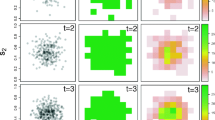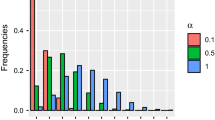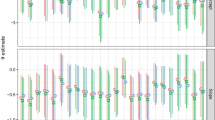Abstract
Royle and Link (Ecology 86(9):2505–2512, 2005) proposed an analytical method that allowed estimation of multinomial distribution parameters and classification probabilities from categorical data measured with error. While useful, we demonstrate algebraically and by simulations that this method yields biased multinomial parameter estimates when the probabilities of correct category classifications vary among sampling units. We address this shortcoming by treating these probabilities as logit-normal random variables within a Bayesian framework. We use Markov chain Monte Carlo to compute Bayes estimates from a simulated sample from the posterior distribution. Based on simulations, this elaborated Royle-Link model yields nearly unbiased estimates of multinomial and correct classification probability estimates when classification probabilities are allowed to vary according to the normal distribution on the logit scale or according to the Beta distribution. The method is illustrated using categorical submersed aquatic vegetation data.
Similar content being viewed by others
References
Angradi TR, Schweiger EW (2005) Aquatic vegetation. In: Angradi TR (ed.). Environmental monitoring and assessment program: great river ecosystems, field operations manual. US environmental protection agency, Duluth, MN. Draft Available. http://www.epa.gov/emfjulte/greatriver/EMAPGREFOM.pdf. Accessed 28 April 2009
Coull BA, Agresti A (1999) The use of mixed logit models to reflect heterogeneity in capture-recapture studies. Biometrics 55: 294–301
Dorazio RM, Royle JA (2003) Mixture models for estimating the size of a closed population when capture rates vary among individuals. Biometrics 59: 351–364
Geyer CJ (2005) mcmc: Markov Chain Monte Carlo. R package version 0.5-1. http://www.stat.umn.edu/geyer/mcmc/
Geyer CJ (2006) trust: Trust Region Optimization. R package version 0.1-1. http://www.stat.umn.edu/geyer/trust/
Langrehr HA, Gray BR, Janvrin JA (2007) Evaluation of aquatic macrophyte community response to island construction in the upper mississippi river. Lakes Reserv 23: 313–320
MacKenzie DI, Nichols JD, Royle JA, Pollock KH, Bailey LL, Hines JE (2006) Occupancy estimation and modeling: inferring patterns and dynamics of species occurrence. Academic Press, San Diego
Otis DL, Burnham KP, White GC, Anderson DR (1978) Statistical inference from capture data on closed animal populations. Wildl Monogr 62: 11–35
Royle JA, Dorazio RM (2006) Hierarchical models of animal abundance and occurence. J Agric Biol Environ Stat 11(3): 249–263
Royle JA, Dorazio RM (2008) Hierarchical modeling and inference in ecology : the analysis of data from populations, metapopulations and communities. Academic, Boston
Royle JA, Link WA (2005) A general class of multinomial mixture models for anuran calling survey data. Ecology 86(9): 2505–2512
Thompson SK (2002) Sampling. 2. Wiley, New York
Shirose LJ, Bishop CA, Green DM, MacDonald CJ, Brooks RJ, Helferty NJ (1997) Validation tests of an amphibian call count survey technique in Ontario, Canada. Herpetologica 53(3): 312–320
Yin Y, Winkelman JS, Langrehr HA (2000) Long term resource monitoring procedures: aquatic vegetation monitoring. US Geological Survey, Upper Midwest environmental sciences center, La Crosse, WI. LTRMP 95-P002-7
Author information
Authors and Affiliations
Corresponding author
Rights and permissions
About this article
Cite this article
Holland, M.D., Gray, B.R. Multinomial mixture model with heterogeneous classification probabilities. Environ Ecol Stat 18, 257–270 (2011). https://doi.org/10.1007/s10651-009-0131-2
Received:
Revised:
Published:
Issue Date:
DOI: https://doi.org/10.1007/s10651-009-0131-2




